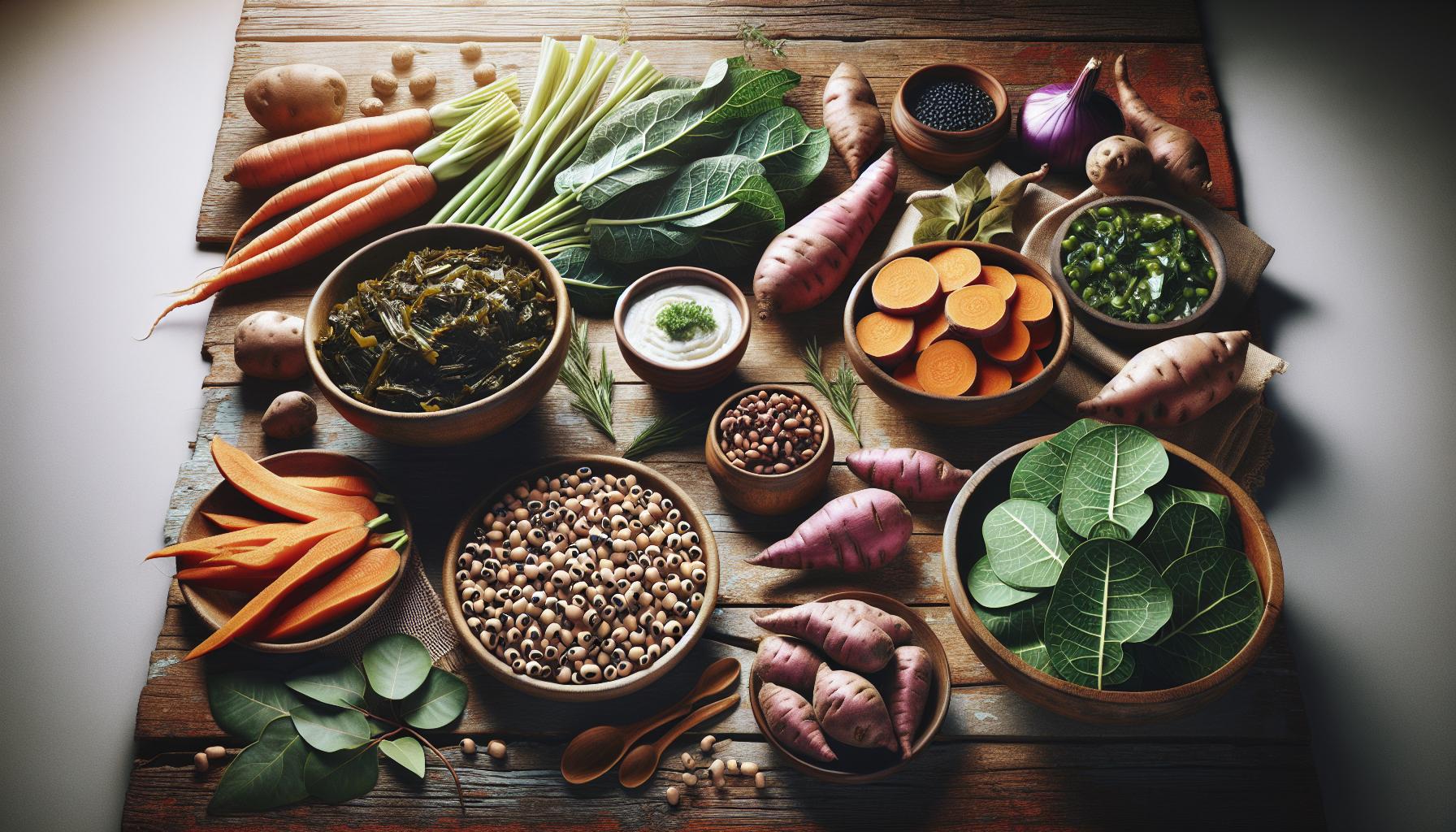Soul food isn’t just about filling the stomach – it’s about feeding the spirit and connecting generations through timeless recipes and traditions. African American cuisine stands as a testament to resilience creativity and the remarkable ability to transform humble ingredients into extraordinary dishes that have shaped American culinary culture.
From crispy fried chicken and smoky collard greens to sweet potato pie and cornbread this cuisine tells a powerful story of heritage survival and celebration. What started in the kitchens of enslaved people has evolved into a beloved cornerstone of American gastronomy influencing everything from home cooking to fine dining establishments across the nation. Today African American food culture continues to evolve while maintaining its deep roots in tradition family gatherings and the art of cooking with love.
The Rich History of African American Cuisine
African American cuisine emerged from centuries of cultural preservation mixed with culinary innovation. The cooking techniques passed down through generations tell a story of resilience adaptability through food.
From Africa to the American South
West African cooking traditions crossed the Atlantic during the transatlantic slave trade, bringing ingredients like okra rice black-eyed peas to American shores. Enslaved Africans combined these familiar ingredients with local produce creating distinctive dishes such as gumbo jambalaya red rice. The practice of slow-cooking tough cuts of meat vegetables in iron pots originated from necessity transformed into flavorful dishes like braised oxtails smothered pork chops. Kitchen gardens maintained by enslaved people introduced crops like collard greens sweet potatoes which became staples of Southern cooking.
Soul Food’s Cultural Significance
Soul food represents a cornerstone of African American cultural identity connecting communities through shared meals gatherings. Sunday dinners after-church suppers became sacred spaces where recipes stories passed between generations. The preservation of cooking techniques like seasoning cast iron skillets smoking meats maintains vital links to ancestral knowledge. Traditional dishes serve as edible archives documenting African American history survival creativity. Modern soul food restaurants celebrate this heritage while adapting recipes for contemporary tastes health considerations. Celebrity chefs food historians document these culinary traditions ensuring their place in American gastronomy.
Essential Soul Food Ingredients and Staples

Soul food’s foundation rests on key ingredients that transform simple elements into flavorful dishes. These staples form the cornerstone of African American culinary traditions, featuring prominently in both everyday meals and special occasions.
Black-Eyed Peas and Rice
Black-eyed peas paired with rice create Hoppin’ John, a signature dish rich in protein and cultural significance. Fresh black-eyed peas contain essential nutrients including fiber, potassium, iron while dried varieties offer extended shelf life. Rice varieties such as Carolina Gold enhance dishes with distinct texture and nutty flavors. Traditional preparations combine these ingredients with smoky ham hocks or salt pork for depth. Home cooks season the combination with bay leaves, garlic thyme to build layers of flavor.
Leafy Greens and Root Vegetables
Collard greens stand as the most iconic leafy green in soul food, accompanied by mustard greens, turnip greens kale. Root vegetables include sweet potatoes, yams rutabaga which provide hearty sustenance. These vegetables often simmer with smoked turkey necks or ham hocks in seasoned pot liquor. Sweet potatoes transform into candied variations or pies featuring warm spices like cinnamon nutmeg allspice. Fresh turnips offer peppery notes while their greens deliver essential vitamins minerals. Garden-fresh ingredients maintain connections to ancestral agricultural practices established during slavery.
| Common Soul Food Vegetables | Nutritional Benefits |
|---|---|
| Collard Greens | Vitamin K, Calcium |
| Sweet Potatoes | Vitamin A, Fiber |
| Black-Eyed Peas | Protein, Iron |
| Turnips | Vitamin C, Potassium |
Traditional Cooking Methods and Techniques
African American cooking techniques reflect generations of culinary expertise passed down through oral traditions. These methods transform basic ingredients into deeply flavorful dishes through time-tested practices.
Slow Cooking and One-Pot Meals
Cast iron pots serve as the foundation of traditional African American cooking methods, enabling the creation of hearty stews, soups, and braised meats. Simmering tough cuts of meat at low temperatures for 4-8 hours breaks down connective tissues, resulting in tender, flavorful dishes. One-pot cooking techniques combine vegetables, meats, and seasonings in a single vessel, allowing flavors to meld while preserving nutrients. Common examples include Brunswick stew, oxtail stew, and smothered chicken with vegetables. This economical approach maximizes limited resources while creating dishes that feed extended families.
Seasoning and Flavor Profiles
Smoke, spice, and umami form the cornerstone flavors in African American cuisine. Smoked meats like ham hocks, turkey wings, and neck bones infuse dishes with rich, complex tastes. Traditional seasoning combinations include:
| Base Seasonings | Aromatic Additions | Common Herbs |
|---|---|---|
| Black pepper | Onions | Bay leaves |
| Garlic powder | Bell peppers | Thyme |
| Cayenne | Celery | Sage |
| Salt | Hot peppers | Parsley |
Layering techniques build depth through multiple stages of cooking, starting with a flavor base of sautéed aromatics called “trinity” (onions, celery, bell peppers). Seasoned oils or rendered fats capture flavors and create distinctive tastes in greens, beans, and vegetables.
Iconic African American Dishes
African American cuisine features distinctive dishes that reflect generations of cultural heritage and culinary expertise. These recipes showcase the ingenuity of turning basic ingredients into memorable meals that continue to influence American dining.
Sunday Dinner Classics
Sunday dinners in African American households center around signature dishes like crispy fried chicken seasoned with paprika and garlic. Mac and cheese, made with sharp cheddar and topped with a golden-brown crust, takes pride of place on the dinner table. Collard greens, simmered with smoked turkey necks or ham hocks, deliver rich flavors alongside cornbread made in seasoned cast-iron skillets. Black-eyed peas cooked with onions and bacon complement rice dishes, while candied yams glazed with butter, brown sugar and cinnamon add sweetness to the spread. Each dish represents time-honored cooking techniques passed through generations.
Holiday and Celebration Foods
Special occasions feature elevated versions of traditional recipes served during major celebrations like Thanksgiving and Christmas. Sweet potato pie spiced with nutmeg and cinnamon appears at holiday gatherings alongside peach cobbler topped with flaky crusts. Seafood gumbo loaded with shrimp, crab and andouille sausage marks special events in coastal regions. Chitlins, carefully cleaned and seasoned, remain a traditional celebration dish in many families. Red velvet cake layered with cream cheese frosting serves as a centerpiece dessert at celebrations. Smothered turkey wings braised in gravy grace tables during family reunions and church celebrations.
The Evolution of Soul Food
Soul food’s transformation reflects the dynamic journey of African American cuisine through generations of cultural shifts. The adaptation of traditional recipes meets contemporary tastes while honoring ancestral cooking methods.
Modern Interpretations
Contemporary soul food embraces innovative culinary techniques while maintaining its cultural essence. Chefs like Marcus Samuelsson blend traditional ingredients with global flavors, creating dishes such as Ethiopian-spiced fried chicken or miso-glazed black-eyed peas. Fine dining establishments elevate classic recipes through modern plating techniques, premium ingredients, and refined cooking methods. Soul food fusion restaurants incorporate elements from Caribbean, Latin American, and Asian cuisines, producing creative combinations like collard green spring rolls or sweet potato biscuits with five-spice butter. Food trucks offer portable versions of soul food classics, adapting traditional recipes for on-the-go dining.
Health-Conscious Adaptations
Modern soul food preparations focus on nutritious alternatives that preserve traditional flavors. Plant-based versions of classic dishes incorporate ingredients like jackfruit for pulled pork, cauliflower for mac and cheese, and mushrooms for smothered chicken. Cooking methods now include air frying, steaming, and baking to reduce oil content. Traditional recipes feature whole grains, reducing refined carbohydrates through alternatives like brown rice, quinoa, or cauliflower rice. Chefs incorporate more fresh vegetables, herbs, and spices to enhance flavor without relying on fatty meats or excessive salt. These adaptations maintain cultural authenticity while addressing contemporary health considerations.
Soul Food’s Impact on American Cuisine
Soul food’s influence on American cuisine extends far beyond African American communities, shaping regional cooking styles and inspiring innovative culinary trends. The integration of soul food techniques and flavors into mainstream American cooking demonstrates its significant cultural impact.
Regional Influences
Soul food traditions vary distinctly across American regions. Southern states like Georgia embrace rich, smoky flavors in dishes such as Brunswick stew and country-fried steak. Louisiana’s soul food incorporates Creole elements, creating distinctive preparations of gumbo and jambalaya. Coastal Carolina regions feature seafood-based soul dishes like Frogmore stew and shrimp and grits. Mid-Atlantic soul food emphasizes preparations with turkey wings and fish. Midwest interpretations blend soul food with heartland ingredients, producing unique takes on classics like smothered pork chops. These regional adaptations showcase soul food’s versatility and its ability to absorb local ingredients while maintaining its core identity.
Celebrity Chefs and Restaurants
Contemporary chefs elevate soul food traditions through innovative interpretations. Marcus Samuelsson’s Red Rooster Harlem combines Ethiopian and Swedish influences with soul food classics. Carla Hall showcases soul food’s versatility through her television appearances and cookbooks. Mashama Bailey’s The Grey in Savannah earned a James Beard Award for transforming traditional soul food elements into fine dining experiences. Tanya Holland’s Brown Sugar Kitchen popularized soul food in California’s Bay Area. Joe Randall’s Cooking School preserves authentic soul food techniques while training new generations of chefs. These culinary leaders demonstrate soul food’s evolution from home kitchens to acclaimed restaurants, earning recognition in the broader culinary landscape.
Conclusion
African American food culture stands as a testament to resilience creativity and love. Through generations of skilled cooks this cuisine has evolved from survival food to celebrated dishes that grace tables across America. The legacy lives on through both traditional family recipes and modern interpretations by innovative chefs.
Today’s soul food continues to honor its roots while embracing new techniques and healthier adaptations. It’s a cuisine that tells the story of a people’s journey and celebrates the power of food to bring families and communities together. As African American culinary traditions continue to influence American gastronomy they remind us that food is more than sustenance – it’s a bridge between past present and future.

